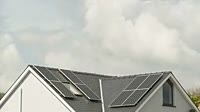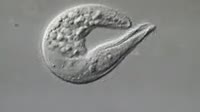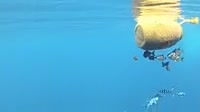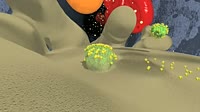Cutaway animation of the formation of an earthquake and tsunami, at a subduction zone. A subduction zone is a region where two tectonic plates are converging, with the denser oceanic plate (left) pushed under the less dense continental plate (right). In close-up, the oceanic plate sticks on the continental plate, deforming the latter and causing a build-up of strain energy (yellow). Eventually the force of the plate movement overcomes the friction causing it to stick, and the plate moves rapidly as the strain energy is released. This causes seismic waves to move through the crust from the focal point, or hypocentre. These waves are felt as an earthquake. The sudden displacement of the seabed also moves a huge volume of water above it, creating a tsunami. This is a vast wave that moves quickly in the open sea, with a very long wavelength and a low amplitude. When it reaches shallow water, the amplitude increases dramatically, and it comes ashore as a series of large waves, many metres in height, that reach far inland. The combination of an earthquake and tsunami can be devastating. The quake does provide some warning about the potential tsunami, as seismic waves travel at some 25, 000 kilometres per hour, while in the open sea a tsunami wave travels at around 800 kilometres per hour.
Details
WebID:
C01807610
Clip Type:
RM
Super High Res Size:
1920X1080
Duration:
00:01:14.000
Format:
QuickTime
Bit Rate:
25 fps
Available:
download
Comp:
200X112 (0.00 M)
Model Release:
NO
Property Release
No













 Loading
Loading